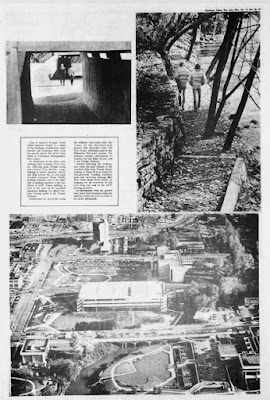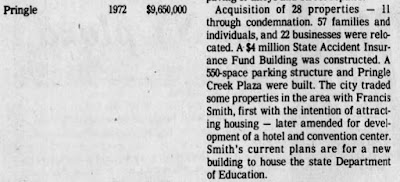Over on FB there's a proposal for refreshing the paths and park areas in the Pringle Creek Urban Renewal Area. Since those areas are not likely to be very significantly altered in the near or even medium term, investing in maintenance and refreshment is reasonable and valuable.
But in discussing it, particularly as trying to understand it as a kind of "stroll garden," we abstract it too quickly from its historical and current urban context.
The Pringle Creek Urban Renewal Area is slack, underused space. It is a waste of valuable downtown land, redeveloped on a surburban, office campus model.
 |
| The area in 1975 (see it in the newspaper below) (Salem Library Historic Photos) |
We can better understand the space as an "ornamental emptiness," which might direct attention to our strategies for ornamenting it and why it stubbornly remains empty.
 |
| Ornamental Emptiness and SAIF, 1974 Salem Library Historic Photos |
Back in 1975 the whole concept and space was anchored by a parking garage. It was very much understood as a drive-to destination.
 |
| LTE, November 1st, 1971 |
Even in 1971 people questioned the cost and utility of a very large parking structure. As the project developed and then was actually constructed, later pieces in the papers focused on the parking garage and on SAIF, and did not focus on the path system and landscaping as any kind of independent value or feature. They were always fitted in secondarily, ways to fill the resulting voids.
 |
| April 25th, 1972 |
 |
| November 12th, 1973 |
The whole area has lousy edges. There are several surface lots in addition to the Pringle Parkade. There is also a busy state highway and Liberty Street, which might as well be a highway. To the south there is a ridge of office and hospital monoculture, and the university to the east. There are only two buildings with homes adjacent to the area, 295 Church and the Lindsey tower.
 |
| The park's edges are busy streets and parking lots |
The greenery might seem to mark a "living" zone, but it's actually a dead zone.
A 1975 piece (with the photo at top) shows an underpass, where now there are often people camping and sometimes using as a bathroom, as well as a path segment between Liberty and High that washed out in the 1996 flood and has not been restored.
 |
| Nov. 30th, 1975 |
Two features they thought were wonderful have not really proved so.
Still later, a piece listed the losses: 28 properties with 57 families and 22 businesses. A cocktail napkin kind of estimate a decade ago suggested that leaving those properties to develop "naturally" would have yielded much greater value. The renewal area did not seem to net anything over inflation, over doing nothing.
 |
| November 15th, 1978 |
No matter how much we invest in better plant material, and even if, as one person suggested, we transferred the Sculpture garden from the Conference Center to the park and path system here, the Pringle Creek Urban Renewal Area and Mill Race Park system lacks active edges and attractors that would enliven it.
On a walk through it a week ago on Sunday, it was utterly deserted. There simply aren't enough businesses and residences on its edges. It is a total ornamental emptiness.
Until we grapple with the way our autoism infects and defeats our hopes for open space, we will continue with ornamental emptinesses instead of vibrant public spaces.
Related, see:


2 comments:
Over on FB a couple of comments:
One person writes: "[the blog prefers] gathering places. I think there is room for calm, silence and escape from the masses."
Preferring gathering places is true. Salem has a multitude of quiet places and people regularly seem to want still more of them. Here, the balance has seemed badly off, and since we live in a city, we should want a greater number of and greater activity in gathering places.
This is a real difference of opinion. We'll continue here to make the case for gathering places and to offer critique of ornamental emptinesses.
Another person: "[they neglect] to mention the many homes along the west edge..."
I assume they mean homes on Gaiety Hill. That's more like the southwest edge, but it's true there are a few homes there. It has not seemed like a very meaningful number, and overstates the cumulative mass of single detached housing, as well as the geography of the hill itself.
But these homes do not immediately border the Pringle Creek Urban Renewal Area. The path system is on the north side of the creek, and the houses start on the south side, generally buffered by commercial lots: Waterplace, the law office, and Woodland church. Then there is Pringle Park and the Hospital. This is why the homes on Gaiety Hill did not seem so significant in this particular argument.
If they mean the homes in Southpark, well, the argument here was more about the area near SAIF than Mirror Pond, but if we are talking about Mirror Pond, that is an important cluster of homes, and they are right to point to that.
(* South Block, not South Park!)
Post a Comment